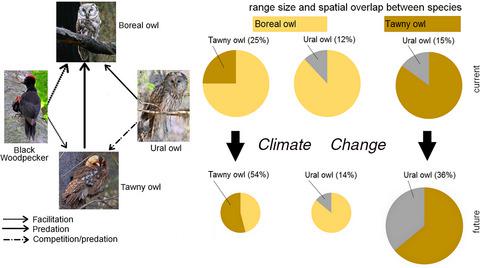当前位置:
X-MOL 学术
›
Glob. Change Biol.
›
论文详情
Our official English website, www.x-mol.net, welcomes your feedback! (Note: you will need to create a separate account there.)
Species interactions and climate change: How the disruption of species co-occurrence will impact on an avian forest guild.
Global Change Biology ( IF 11.6 ) Pub Date : 2019-12-05 , DOI: 10.1111/gcb.14953 Mattia Brambilla 1, 2 , Davide Scridel 1, 3 , Gaia Bazzi 2 , Luca Ilahiane 2 , Aaron Iemma 1 , Paolo Pedrini 1 , Enrico Bassi 4 , Radames Bionda 5 , Luigi Marchesi 1 , Fulvio Genero 6 , Norbert Teufelbauer 7 , Remo Probst 7 , Al Vrezec 8 , Primož Kmecl 9 , Tomaž Mihelič 9 , Giuseppe Bogliani 3 , Hans Schmid 10 , Giacomo Assandri 1, 3 , Renato Pontarini 11 , Veronika Braunisch 12 , Raphaël Arlettaz 12 , Dan Chamberlain 13
Global Change Biology ( IF 11.6 ) Pub Date : 2019-12-05 , DOI: 10.1111/gcb.14953 Mattia Brambilla 1, 2 , Davide Scridel 1, 3 , Gaia Bazzi 2 , Luca Ilahiane 2 , Aaron Iemma 1 , Paolo Pedrini 1 , Enrico Bassi 4 , Radames Bionda 5 , Luigi Marchesi 1 , Fulvio Genero 6 , Norbert Teufelbauer 7 , Remo Probst 7 , Al Vrezec 8 , Primož Kmecl 9 , Tomaž Mihelič 9 , Giuseppe Bogliani 3 , Hans Schmid 10 , Giacomo Assandri 1, 3 , Renato Pontarini 11 , Veronika Braunisch 12 , Raphaël Arlettaz 12 , Dan Chamberlain 13
Affiliation

|
Interspecific interactions are crucial in determining species occurrence and community assembly. Understanding these interactions is thus essential for correctly predicting species' responses to climate change. We focussed on an avian forest guild of four hole-nesting species with differing sensitivities to climate that show a range of well-understood reciprocal interactions, including facilitation, competition and predation. We modelled the potential distributions of black woodpecker and boreal, tawny and Ural owl, and tested whether the spatial patterns of the more widespread species (excluding Ural owl) were shaped by interspecific interactions. We then modelled the potential future distributions of all four species, evaluating how the predicted changes will alter the overlap between the species' ranges, and hence the spatial outcomes of interactions. Forest cover/type and climate were important determinants of habitat suitability for all species. Field data analysed with N-mixture models revealed effects of interspecific interactions on current species abundance, especially in boreal owl (positive effects of black woodpecker, negative effects of tawny owl). Climate change will impact the assemblage both at species and guild levels, as the potential area of range overlap, relevant for species interactions, will change in both proportion and extent in the future. Boreal owl, the most climate-sensitive species in the guild, will retreat, and the range overlap with its main predator, tawny owl, will increase in the remaining suitable area: climate change will thus impact on boreal owl both directly and indirectly. Climate change will cause the geographical alteration or disruption of species interaction networks, with different consequences for the species belonging to the guild and a likely spatial increase of competition and/or intraguild predation. Our work shows significant interactions and important potential changes in the overlap of areas suitable for the interacting species, which reinforce the importance of including relevant biotic interactions in predictive climate change models for increasing forecast accuracy.
中文翻译:

物种相互作用与气候变化:物种共生的破坏将如何影响鸟类森林协会。
种间相互作用对于确定物种的发生和群落组装至关重要。因此,了解这些相互作用对于正确预测物种对气候变化的反应至关重要。我们重点研究了对四种洞巢物种的鸟类森林行会,它们对气候的敏感性不同,它们表现出一系列易于理解的相互关系,包括促进,竞争和掠夺。我们对黑啄木鸟和北方,黄褐色和乌拉尔猫头鹰的潜在分布进行了建模,并测试了物种间相互作用是否影响了更广泛的物种(不包括乌拉尔猫头鹰)的空间格局。然后,我们对所有四个物种的潜在未来分布进行建模,评估预测的变化将如何改变物种范围之间的重叠,因此互动的空间结果。森林覆盖率/类型和气候是所有物种栖息地适宜性的重要决定因素。用N-混合物模型分析的实地数据揭示了种间相互作用对当前物种丰富度的影响,特别是在北方猫头鹰中(黑啄木鸟的正面影响,黄褐色的猫头鹰的负面影响)。气候变化将在物种和行会层面上影响这一组合,因为与物种相互作用有关的潜在范围重叠区域在未来将在比例和范围上发生变化。北方猫头鹰是行会中对气候最敏感的物种,它将退缩,并且与主要捕食者黄褐色的猫头鹰重叠的范围将在剩余的合适区域内增加:气候变化因此将直接或间接地影响北方猫头鹰。气候变化将导致物种相互作用网络的地理改变或破坏,对属于行会的物种产生不同的后果,竞争和/或行会内部捕食的空间可能会增加。我们的工作表明,在适用于相互影响物种的区域重叠区域中,存在重大交互作用和潜在的重要变化,这增强了在预测性气候变化模型中纳入相关生物交互作用以提高预测准确性的重要性。
更新日期:2020-01-11
中文翻译:

物种相互作用与气候变化:物种共生的破坏将如何影响鸟类森林协会。
种间相互作用对于确定物种的发生和群落组装至关重要。因此,了解这些相互作用对于正确预测物种对气候变化的反应至关重要。我们重点研究了对四种洞巢物种的鸟类森林行会,它们对气候的敏感性不同,它们表现出一系列易于理解的相互关系,包括促进,竞争和掠夺。我们对黑啄木鸟和北方,黄褐色和乌拉尔猫头鹰的潜在分布进行了建模,并测试了物种间相互作用是否影响了更广泛的物种(不包括乌拉尔猫头鹰)的空间格局。然后,我们对所有四个物种的潜在未来分布进行建模,评估预测的变化将如何改变物种范围之间的重叠,因此互动的空间结果。森林覆盖率/类型和气候是所有物种栖息地适宜性的重要决定因素。用N-混合物模型分析的实地数据揭示了种间相互作用对当前物种丰富度的影响,特别是在北方猫头鹰中(黑啄木鸟的正面影响,黄褐色的猫头鹰的负面影响)。气候变化将在物种和行会层面上影响这一组合,因为与物种相互作用有关的潜在范围重叠区域在未来将在比例和范围上发生变化。北方猫头鹰是行会中对气候最敏感的物种,它将退缩,并且与主要捕食者黄褐色的猫头鹰重叠的范围将在剩余的合适区域内增加:气候变化因此将直接或间接地影响北方猫头鹰。气候变化将导致物种相互作用网络的地理改变或破坏,对属于行会的物种产生不同的后果,竞争和/或行会内部捕食的空间可能会增加。我们的工作表明,在适用于相互影响物种的区域重叠区域中,存在重大交互作用和潜在的重要变化,这增强了在预测性气候变化模型中纳入相关生物交互作用以提高预测准确性的重要性。


























 京公网安备 11010802027423号
京公网安备 11010802027423号